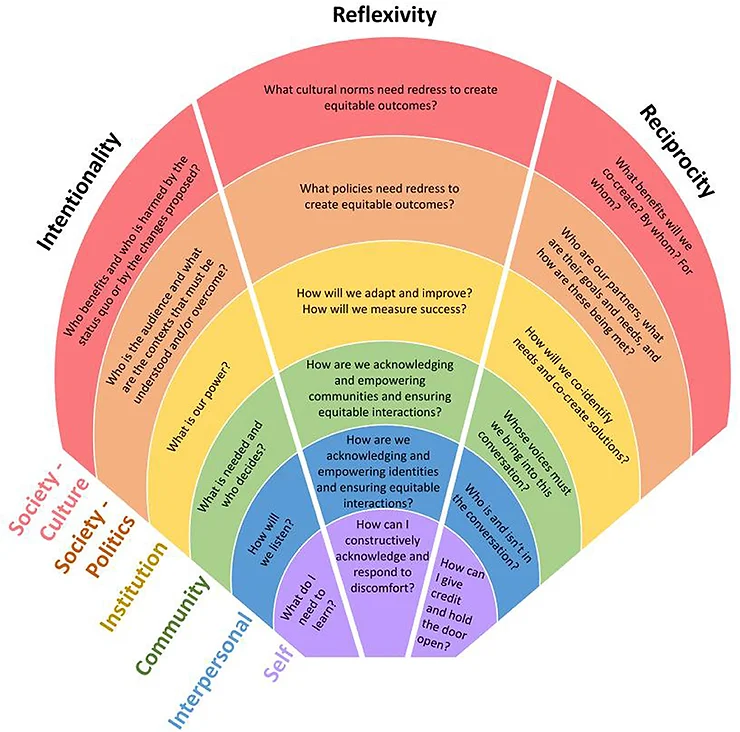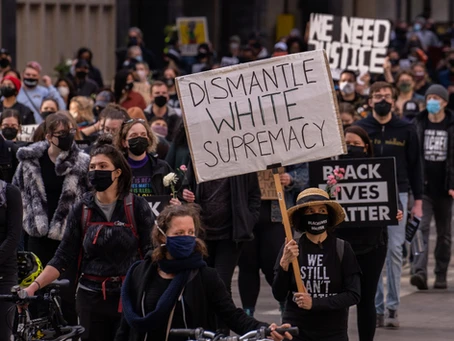Strategies for Confronting White Supremacy Culture in SciComm
By Carolyn Pralle
Title: Acknowledging and Supplanting White Supremacy Culture in Science Communication and STEM: The Role of Science Communication Trainers
Author(s) and Year: Karlisa A. Callwood, Marissa Weiss, Rose Hendricks, Temis G. Taylor; Published in 2022
Journal: Frontiers in Communication (Open Access)
Disclaimer: The authors of today’s paper possess close ties with the Science Communication Trainers Network, with whom SciCommBites maintains a partnership. However, the post author has no connection with this paper and the paper authors had no involvement in the production of this post.
| TL;DR: Racism and white supremacy culture (WSC) are baked into STEM fields, including SciComm. Among our best tools for dismantling racism and WSC in SciComm is a multilayered approach centering inclusive science communication.Why I chose this paper: After the racist massacre in Buffalo, NY on May 14, 2022, I felt horrified and yet unnervingly numb. While reading this article, I realized that my reaction played right into the hands of white supremacy culture. Writing this piece is only a small act to confront that, but it feels like a step in the right direction. |
The Background
In this Perspective article, Callwood, Weiss, Hendricks, and Taylor begin with a pivotal reminder: racism and white supremacy culture (WSC) permeate the broad fields of Science, Technology, Engineering, and Math (STEM), oozing deep within STEM education, research, and communication. WSC is cruel, extending privileges to White people while enforcing disadvantages for groups such as Black, Indigenous, and Latinx people, as well as other minoritized identities. To confront the pernicious impacts of white supremacy culture, the authors state: “Our purpose in describing WSC in STEM institutions and SciComm is to name it so we can see it and change it.” The authors suggest three key questions and four core themes to guide actions for readers to consider when addressing WSC.
The customs of white supremacy culture are both overt and subtle. Direct incidents of racism tend to get the most attention within the world of WSC. Yet, more insidious harms are also subtly reinforced through lack of representation, lack of funding, and the alienation and disregard of Black, Indigenous, and Latinx audiences.To outline the consequences of WSC in SciComm, the authors draw upon a list of WSC characteristics identified by Jones and Okun in 2001. Here are a few examples:
- The WSC trait of “Right to comfort” for leaders prods people to silence and scapegoat anyone who makes those in power uncomfortable, stifling genuine experiences and emotions.
- “Perfectionism” discourages attempts to communicate science because we are terrified of making mistakes. For fear of messing up, we don’t collaborate or ask for help.
- “Defensiveness” misdirects our focus away from systemic change. We fight charges rather than sources of racism and address problems on a one-off basis.
Science communicators, especially science communication trainers, have the capacity to work for systemic change and the dismantling of white supremacy culture. For example, the authors cite The Civic Science Imperative, a study exploring the relationships between science communication and public health. To help SciCommers engage in the dismantling of WSC, Callwood and her coauthors describe a framework for building a more effective, more racially inclusive culture in STEM.
Three Key Questions
The authors invite readers to explore three key questions about white supremacy culture and STEM, detailed below.
1. Who does WSC in STEM harm, and how are they harmed?
In simplest terms, WSC harms us all. But, more specifically, underrepresented scholars such as those from Black, Indigenous, and Latinx communities are speaking out through social media (e.g., #BlackIn), affinity/advocacy groups (e.g., 500 Women Scientists), presentations, and films. These scholars frequently tell of disproportionate barriers, biases, and hostile situations within STEM institutions. WSC blinds White people to these real stories, falsely claims institutional colorblindness, ultimately perpetuating the same cycles of harm.
2. What is the role of SciComm in perpetuating and dismantling WSC in STEM?
SciCommers (including researchers, practitioners, and trainers) mainly perpetuate WSC in STEM by following the well-worn path of focusing on White people. By disproportionately telling stories about White scientists and training White SciCommers, we further entrench WSC. To dismantle WSC and disrupt these harmful patterns, SciCommers can employ new models and frameworks, leaning into the history of SciComm trainers leading cultural changes (e.g., Canfield & Menezes, 2020). Callwood and her coauthors recommend greater focus on SciComm outreach and engagement, especially with underrepresented communities to create “authentic multicultural enterprise” in STEM.
3. Who is responsible for designing and implementing solutions?
Designing and implementing solutions is a challenging responsibility and opportunity for any SciCommer. Callwood and her coauthors point out that nearly all of the characteristics of WSC identified by Jones and Okun in 2001 like perfectionism and defensiveness define markers of success in STEM fields. That means designing and implementing solutions for racial equity and justice in STEM will seem intensely abnormal, because these solutions will counter long-standing institutionally inherited WSC norms. SciCommers and their institutional partners must reimagine practices for hiring, funding, and publishing scientists, as well as determining whose work and ideas are valued. By shifting away from the deficit model of SciComm into an Inclusive SciComm model, we can diversify science stories, engage more diverse audiences, and work to dismantle WSC.
A Framework for Change
Callwood, Weiss, Hendricks, and Taylor offer “four core themes for action” in their framework for change, briefly summarized below.
1. Authentic Interrogation, Acknowledgment, and Accountability
To dismantle WSC, we need to know it for what it is and be explicitly clear about the complicity of STEM and SciComm in historic and contemporary oppressions. Only by interrogating and acknowledging those harms can we hold people and institutions accountable, then move forward.
2. Representation
By valuing diversity and equitably representing people from underrepresented groups (e.g. Black, Indigenous, and Latinx scholars) in STEM (including SciComm), we can better solve problems and supplant WSC. The authors recommend that SciCommers prioritize stories about and with underrepresented scientists, and that trainers especially work to dissolve barriers for SciComm training both logistical (e.g. cost, scheduling) and psychological (lack of diversity and inclusivity).
3. Culturally Responsive Practice
Abandoning the deficit model for an Inclusive SciComm model allows for more culturally responsive practice and greater success disrupting WSC. By honoring many ways of knowing and enabling the expression of participants’ own voices, histories, and cultures, SciCommers can more effectively engage with and build lasting relationships among audiences in STEM, SciComm, and SciComm training.
4. Inclusion
Inclusion involves working together, countering the exclusionary tactics and characteristics of WSC. As illustrated in Figure 1, the authors offer a scaffolded set of questions under the inclusive frames of Intentionality, Reciprocity, and Reflexivity. In this framework, the authors describe intentionality to mean carefully considering the needs and preferences of our audiences. Reciprocity means valuing varied forms of expertise and addressing past and present inequities. Reflexivity means “continuous, critical, and systematic reflection” on the identities and experiences of SciCommers and audiences, plus a willingness to change and try new approaches as needed. Each question in the framework nests within a different “sphere of influence” ranging from the most immediate Self through the increasingly interwoven spheres of the Interpersonal, Community, Institution, Society-Politics and Society-Culture.

The Impact
We are invited to use the themes and questions of this framework as prompts for personal reflection and collective action. Through this framework, Callwood, Weiss, Hendricks, and Taylor welcome SciCommers to seize opportunities to dismantle white supremacy culture. As a demonstration of this Inclusive SciComm work, the authors invite ongoing feedback and co-creation of their framework as an open-source iterative process.
Edited by Kirsten Giesbrecht and Stephanie Deppe
Cover image credit: [Chad Davis via Flickr, CC BY-SA 2.0]

